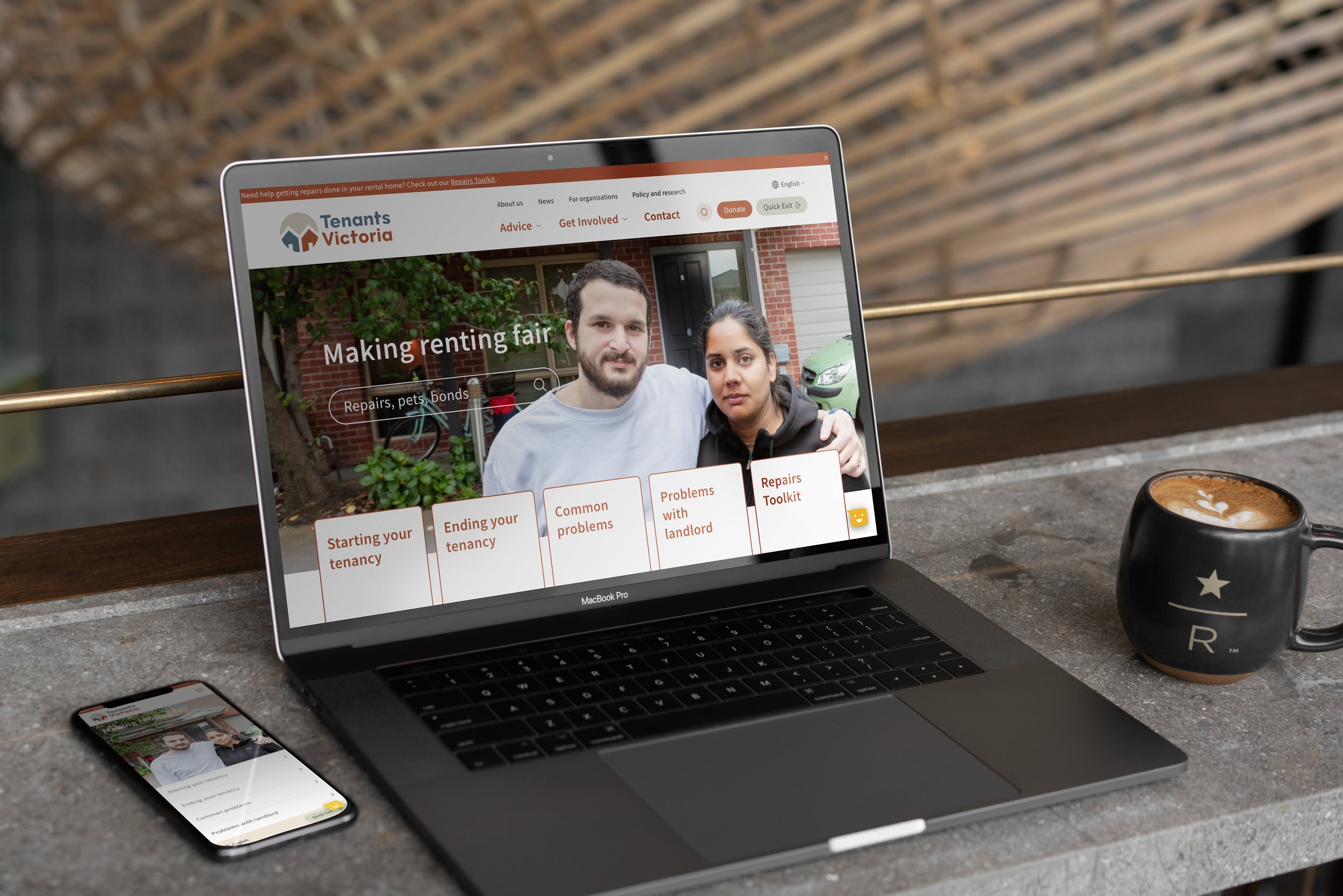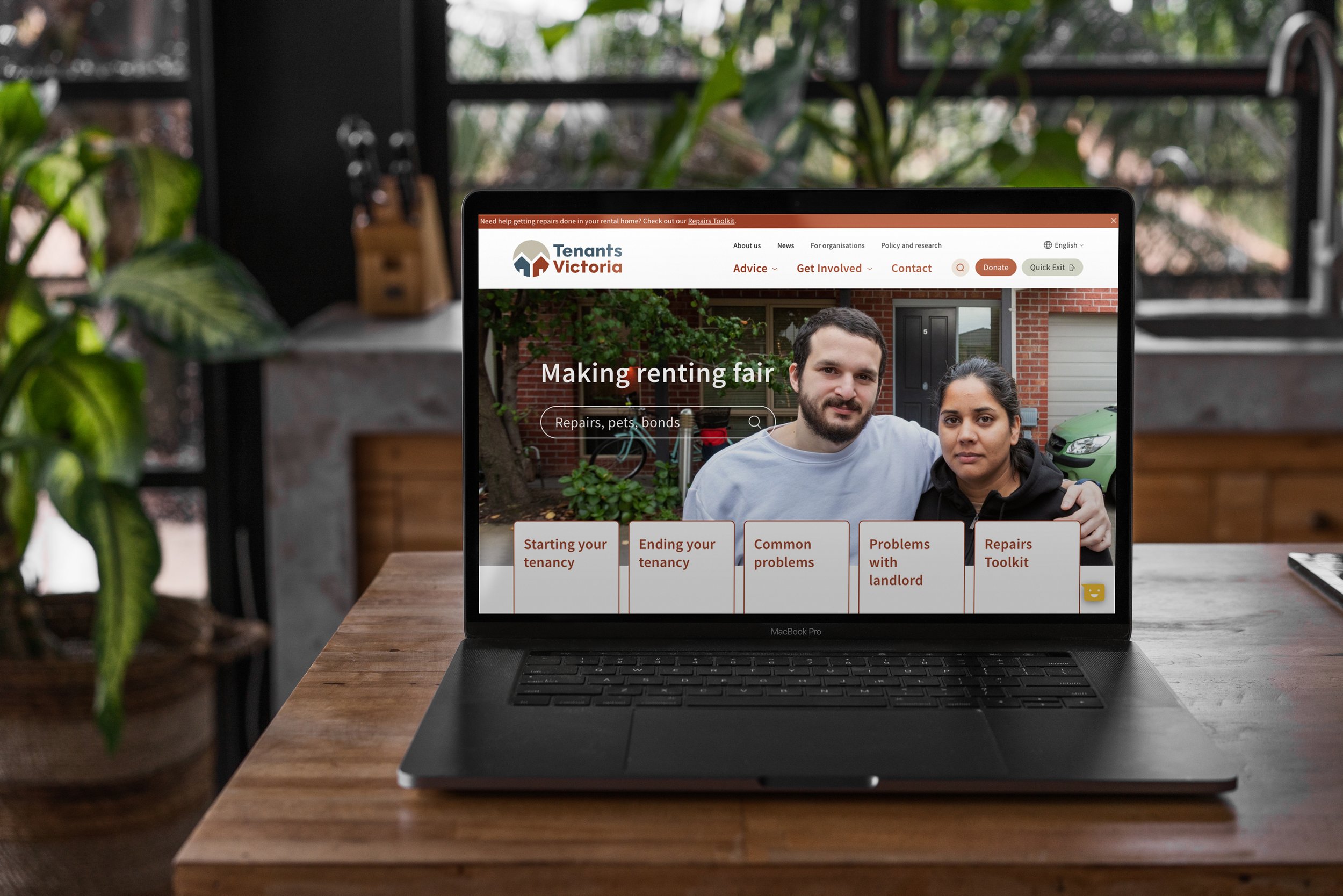
Tenants Victoria:
Website Upgrade
Project type: Project Management, UI Research, Instructional Design
Role: Project Manager, UI Researcher, Instructional Designer
Tools: Asana, MIRO
A multi-phased website upgrade project.
This project included migrating to a new server, migrating all content, creating internal documentation processes to create organisational sustainability, rolling out backend functionality fixes, installing new plugins and front-end features, and designing a new UI interface.

Project Overview
Why is the Tenants Victoria website important?
From finding out how to break a lease, to finding the process for getting a pet, Tenants Victoria website is a hub for Victorians to find renter-focused legal information. Its audience encompasses all Victorian private renters, young and old, who need to know what their renting rights are, often in stressful situations.
The organisation does its best to help thousands of renters every year through their one-on-one legal phone service, but as a small non-profit organisation, its resources are limited. A clear, well-functioning website is essential to being able deliver information and help to those who can’t get through on the phones.
Project Background
Unfortunately the website was originally delivered with several functionality issues and I was brought on to manage the website and fix these issues and then to make future feature and interface updates.
Our overarching goal was to move to a more sustainable, agile approach, where more web management skills were brought in-house, to retain budget and decrease our reliance on external contractors.
The rollout of the new MVP, and additional improvements of the website, both functional, and aesthetic, were executed in 3 distinct phases: Phase 1 - Reclaim IP , Phase 2 - Update Functionality, and Phase 3 - Improve UI.
I’ve described Phase 1 in detail below.
I worked with external videographer company Studio Kettle and project managed the creation of Maryann’s story as well as 4 other renter interviews. Read more about the videos on the Tenants Victoria - Branding project page.
“It’s a great website to have that little bit of security to know what you can and cannot do”
Phase 1: Reclaim IP
Without maintaining a high quality product and building internal knowledge, skills and capacity, organisations can make themselves vulnerable to the marketing strategies of the digital consultancy industry. Healthy projects promote internal skill-sharing, documentation creation, and the preservation of skills to maintain a good environment for current and future employees and projects
Build and run a tight ship (and make it an agile one)
The first goal for any project is to have strong processes. Working with an external web developer strategist, We created a solid agile kanban chart process for executing all web development projects and sprints. We built this on project management platform Asana, and created notifications and automations for checks and balances for progressing projects through each step.
Once we were set up and had chosen a new ongoing web developer it was time to start fixing issues, and running sprints and tasks through our new processes.
MVP: Fix up existing errors
The new website needed several structural existing issues fixed in order to run smoothly and before we could start adding features. We worked with the strategic developer and prioritised each tasks and quoted out the tasks based referring back to the budget and then sending it through our kanban chart process.
Here are a few example of the type of tasks that we completed in this phase:
Add Timestamps on pages
Increase assessibility through new plugin, text sizing and alignment capabilities
Improve navigation by fixing breadcrumb layout and links
Clean up redirect links from legacy site
Remove excess language plugins causing code issues
Designate test pages for smart plugin updater
Bolster internal capacity
I documented all web processes in a 265+ page master web guide document covering how to execute each web admin skill, including steps on what to do in emergencies.
Now that we had a process and a guide, as well as collection of tasks, I was able to start training the team about how to go through each web admin processes, and provided the guide as supplemental material.
We also needed to makes sure we had autonomy over our web server and plugins, and so we migrated our website to a new server that had smart plugin updating, feeding in 20 example pages in to act as a test, and migrated all plugins into our own names.


